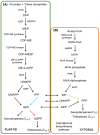Cannabis sativa: Interdisciplinary Strategies and Avenues for Medical and Commercial Progression Outside of CBD and THC
- PMID: 33652704
- PMCID: PMC7996784
- DOI: 10.3390/biomedicines9030234
Cannabis sativa: Interdisciplinary Strategies and Avenues for Medical and Commercial Progression Outside of CBD and THC
Abstract
Cannabis sativa (Cannabis) is one of the world's most well-known, yet maligned plant species. However, significant recent research is starting to unveil the potential of Cannabis to produce secondary compounds that may offer a suite of medical benefits, elevating this unique plant species from its illicit narcotic status into a genuine biopharmaceutical. This review summarises the lengthy history of Cannabis and details the molecular pathways that underpin the production of key secondary metabolites that may confer medical efficacy. We also provide an up-to-date summary of the molecular targets and potential of the relatively unknown minor compounds offered by the Cannabis plant. Furthermore, we detail the recent advances in plant science, as well as synthetic biology, and the pharmacology surrounding Cannabis. Given the relative infancy of Cannabis research, we go on to highlight the parallels to previous research conducted in another medically relevant and versatile plant, Papaver somniferum (opium poppy), as an indicator of the possible future direction of Cannabis plant biology. Overall, this review highlights the future directions of cannabis research outside of the medical biology aspects of its well-characterised constituents and explores additional avenues for the potential improvement of the medical potential of the Cannabis plant.
Keywords: Cannabis sativa (Cannabis); Papaver somniferum (opium poppy); cannabidiol (CBD); cannabinoid receptors (CB1 and CB2); cannabinoids; secondary metabolites; tetrahydrocannabinol (THC).
Conflict of interest statement
The authors declare no conflict of interest.
Figures



References
-
- Clarke R.C., Merlin M.D. Letter to the Editor: Small, Ernest. 2015. Evolution and Classification of Cannabis sativa (Marijuana, Hemp) in Relation to Human Utilization. Bot. Rev. 2015;81:295–305. doi: 10.1007/s12229-015-9158-2. - DOI
-
- Schultes R.E., Klein W.M., Plowman T., Lockwood T.E. Cannabis: An Example of Taxonomic Neglect. Bot. Museum Leafl. Harvard Univ. 1974;23:337–367.
-
- Small E. Evolution and Classification of Cannabis sativa (Marijuana, Hemp) in Relation to Human Utilization. Bot. Rev. 2015;81:189–294. doi: 10.1007/s12229-015-9157-3. - DOI
-
- Small E., Cronquist A. A Practical and Natural Taxonomy for Cannabis. Taxon. 1976;25:405–435. doi: 10.2307/1220524. - DOI
-
- Small E., Naraine S.G.U. Size Matters: Evolution of Large Drug-Secreting Resin Glands in Elite Pharmaceutical Strains of Cannabis sativa (Marijuana) Genet. Resour. Crop Evol. 2016;254:349–359. doi: 10.1007/s10722-015-0254-2. - DOI
Publication types
LinkOut - more resources
Full Text Sources
Other Literature Sources

